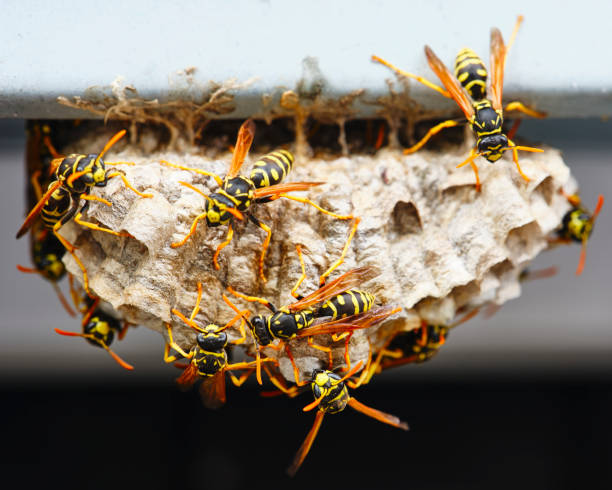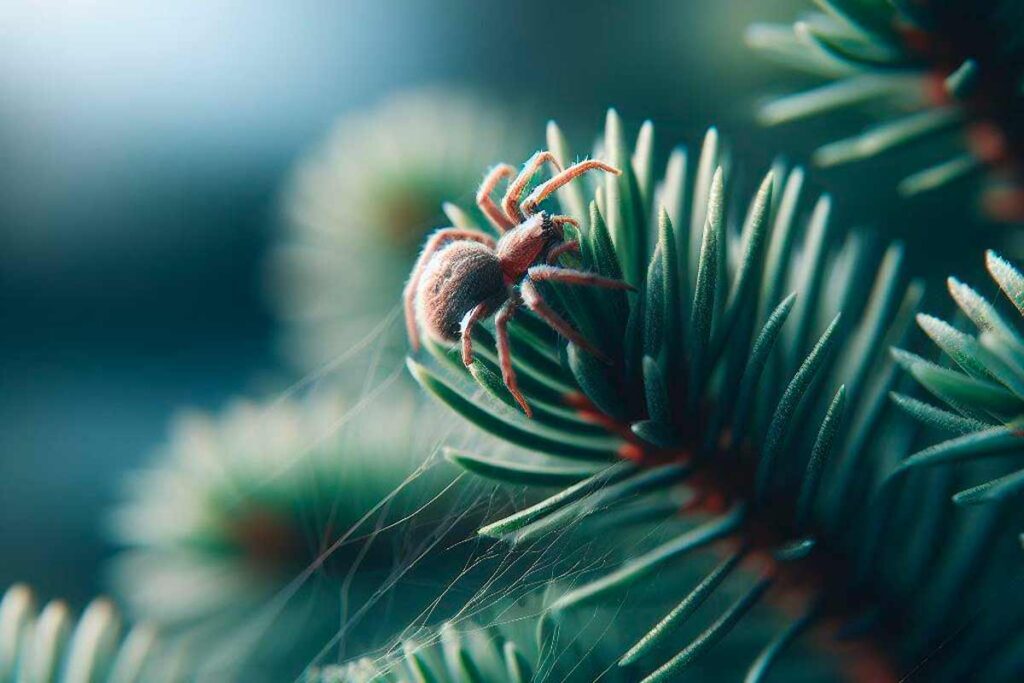Do Carpenter Bees Sting?
Carpenter bees, often mistaken for bumblebees due to their similar appearance, pose a unique question for homeowners: Do they sting? While male carpenter bees are territorial and may hover near humans, they lack a stinger and are harmless. Female carpenter bees, on the other hand, do have a stinger but are generally non-aggressive and sting only when provoked. Instances of carpenter bee stings are rare, making them less of a stinging threat but more of a concern for the structural damage they can cause to wooden elements of homes.

Understanding Carpenter Bees in Homes
In the idyllic settings of suburban neighborhoods, where the rhythmic sounds of nature blend seamlessly with the tranquility of well-kept gardens and wooden patios, a subtle yet persistent buzz often goes unnoticed. This buzz, originating from a creature often mistaken for the common bumblebee, is the telltale sign of the carpenter bee. These solitary insects, known for their distinctive appearance and unique nesting habits, are more than just a fleeting presence in your backyard. They represent a nuanced threat, one that intertwines the delicate balance of nature with the integrity of our cherished homes.
Carpenter bees, with their robust bodies and shiny, hairless abdomens, are often seen hovering around eaves, decks, and garden sheds. At first glance, they appear as benign as any other backyard insect. However, beneath this harmless facade lies a creature capable of causing significant damage to wooden structures. Unlike their more social relatives, the honeybees and bumblebees, carpenter bees are solitary creatures, each female establishing her own nest by burrowing into wood. This nesting behavior, while fascinating from a biological standpoint, poses a real challenge for homeowners, as it can lead to the gradual deterioration of wooden beams, decks, and furniture.
The threat posed by carpenter bees is twofold. On the one hand, there is the physical damage to property, a concern that often remains hidden until significant harm has been done. On the other hand, there is the potential for a sting. While male carpenter bees are often seen as the more aggressive sex, darting towards any perceived threat to their territory, they are, in fact, stingless. It is the female carpenter bee that possesses a stinger. However, stings are rare and usually occur only when these insects are directly provoked or handled.
This article delves into the world of carpenter bees, unraveling the myths and realities surrounding these insects. It aims to provide homeowners with a comprehensive understanding of the carpenter bee’s behavior, the risks they pose, and the most effective strategies for managing their presence. From the nuances of their wood-boring habits to the environmental considerations of controlling their population, we explore the multifaceted challenge they present to suburban living. As we navigate through this exploration, the goal remains clear: to equip homeowners with the knowledge and tools necessary to coexist with these creatures while safeguarding the sanctity and safety of their homes.
Carpenter Bees At A Glance
Nature of the Sting
Understanding the nature of a carpenter bee sting is essential for homeowners, especially those who might encounter these insects around their properties. While the likelihood of being stung by a carpenter bee is low, being informed about what to expect and how to react is crucial.
A carpenter bee sting, much like those of other bees, can be painful. The sting is delivered through a sharp, pointed stinger, which the bee uses as a defense mechanism. The sensation is often described as a sharp, burning pain that occurs at the site of the sting. This is followed by redness and swelling, typical of bee stings. The severity and duration of the pain can vary depending on the individual’s pain tolerance and sensitivity.
Carpenter bee stings are similar in intensity to bumblebee stings. However, they are generally less painful than stings from wasps or honeybees. This is partly because carpenter bees are less aggressive and less likely to sting unless directly provoked. Additionally, unlike honeybees, carpenter bees do not leave their stinger in the skin, which means the venom is not continuously pumped into the wound.
If stung by a carpenter bee, the first step is to remain calm. Panic can exacerbate the situation, especially if there are multiple bees in the vicinity. The affected area should be cleaned with soap and water to prevent infection. Applying a cold pack can help reduce swelling and alleviate pain. Over-the-counter pain relievers and anti-inflammatory medications can also be used to manage discomfort.
While most people will only experience temporary discomfort from a carpenter bee sting, it’s important to monitor for signs of an allergic reaction. Symptoms such as hives, difficulty breathing, swelling of the face, throat, or tongue, dizziness, or a rapid heartbeat warrant immediate medical attention. Those with known allergies to bee stings should carry an epinephrine auto-injector (EpiPen) and seek emergency care following a sting.
For the majority of individuals, the effects of a carpenter bee sting are short-lived, with pain and swelling subsiding within a few hours to a couple of days. In rare cases, individuals may develop a secondary infection at the sting site or experience prolonged swelling and redness. Consulting a healthcare provider is advisable if symptoms persist or worsen.
To minimize the risk of being stung, homeowners should take steps to deter carpenter bees from nesting in or around their homes. This includes sealing holes in wood structures, using bee repellent sprays, and maintaining painted or varnished wood surfaces, as carpenter bees prefer untreated wood for nesting.
While a carpenter bee sting can be an unpleasant experience, understanding its nature and knowing how to respond effectively can mitigate the risks and consequences. By taking preventive measures and being prepared to treat a sting, homeowners can coexist with these insects with minimal conflict.
Health and Safety At A Glance
Female Carpenter Bees: The Only Stingers
In the intricate world of carpenter bees, the distinction between males and females goes beyond physical differences; it extends into their roles and behaviors, particularly when it comes to the capability to sting. Understanding this aspect is crucial for homeowners who might encounter these bees.
Female carpenter bees are equipped with a stinger, a feature absent in their male counterparts. This stinger is not just a defensive tool but also a part of their reproductive anatomy. Unlike honeybees, carpenter bees do not lose their stinger and die after stinging; they can sting multiple times if they feel threatened.
Despite having a stinger, female carpenter bees are not naturally aggressive. They do not exhibit the protective behavior seen in some social bee species that aggressively defend their hives. Female carpenter bees will generally only sting when they feel directly threatened, such as when they are handled, stepped on, or if their nest is disturbed.
Stings from female carpenter bees are quite rare. These bees are solitary, focusing more on nest building and foraging than on human interaction. Most encounters with humans occur inadvertently, and even then, the bees’ first instinct is usually to flee rather than attack.
For the average person, a sting from a carpenter bee is comparable to that of a bumblebee – painful but generally harmless. The sting site may become red, swollen, and itchy. However, these symptoms are typically localized and short-lived.
The primary concern with carpenter bee stings arises for individuals with bee sting allergies. For these people, a sting can trigger a systemic allergic reaction, ranging from mild to severe. Symptoms can include hives, swelling in areas of the body away from the sting site, difficulty breathing, dizziness, and in severe cases, anaphylactic shock.
Homeowners who are aware of carpenter bees in their vicinity should take precautionary measures, especially during the bees’ active months. Keeping a safe distance from known nesting sites and refraining from disturbing the bees can prevent most stings. For those with known allergies, carrying an epinephrine auto-injector (EpiPen) and wearing protective clothing when in areas with high bee activity can be life-saving measures.
The female carpenter bee, the sole possessor of a stinger in her species, is generally non-aggressive and unlikely to sting unless provoked. Understanding this behavior can help homeowners coexist peacefully with these bees. Taking simple precautions can minimize the risk of stings, ensuring safety for both humans and the bees, who play a vital role in our ecosystem.
Did You Know?
Frequency of Stings in Urban and Suburban Settings
In the densely populated landscapes of urban and suburban areas, the interaction between humans and wildlife, including carpenter bees, is inevitable. Understanding the frequency of carpenter bee stings in these settings is crucial for homeowners and residents, as it shapes their approach to managing these insects and ensuring safety.
Urban and suburban environments, with their abundance of wooden structures like decks, fences, and garden furniture, provide ideal habitats for carpenter bees. This proximity inevitably leads to increased encounters between humans and these bees. However, despite the higher likelihood of coming into contact with carpenter bees in these areas, the incidence of stings remains remarkably low. This low frequency is primarily due to the non-aggressive nature of carpenter bees and their general disinterest in human interaction.
Carpenter bees are solitary creatures, focused more on their nesting activities than on human activities. They are not territorial in the way that some social bees and wasps are, and they do not have a colony or hive to defend. This solitary nature contributes to their generally passive behavior towards humans. The males, although they may exhibit aggressive flight patterns when people are near their territory, are incapable of stinging. Female carpenter bees, capable of stinging, do so very rarely and usually only when directly provoked or handled.
In urban and suburban gardens, carpenter bees play a vital role as pollinators. Their presence is often welcomed by gardeners for the benefits they bring to plants and flowers. In these settings, people are more likely to encounter carpenter bees, but the bees’ focus on pollination activities further reduces the chances of stinging incidents.
The frequency of stings can also be influenced by human behavior. In urban and suburban settings, activities such as outdoor construction, gardening, and children playing near carpenter bee nesting areas can increase the likelihood of accidental encounters. Educating those involved in such activities about the presence of carpenter bees and how to avoid provoking them can help in reducing the already low risk of stings.
Local health departments and wildlife agencies sometimes track and report incidents of bee stings, including those from carpenter bees. However, due to the low frequency of such events, comprehensive data specifically on carpenter bee stings in urban and suburban areas is limited.
While the frequency of carpenter bee stings in urban and suburban settings is higher than in more rural areas, it remains a rare occurrence. The non-aggressive nature of these bees, combined with an understanding and respect for their behavior, significantly minimizes the risk of stings. Homeowners and residents can coexist peacefully with these important pollinators by staying informed and taking simple precautions.

Educating Children and Guests
In areas where carpenter bees are prevalent, educating children and guests about these insects becomes an essential aspect of home safety. This education not only helps in preventing potential stings but also in fostering a respectful coexistence with these important pollinators.
The first step in education is to help children and guests understand what carpenter bees are. Unlike more aggressive species, carpenter bees are generally not interested in humans. They are solitary bees, and their primary focus is on building nests in wood, not seeking out people to sting. Explaining this can alleviate undue fear and promote a calmer approach when encountering these bees.
Children, in particular, are naturally curious and may be tempted to explore or play near areas where carpenter bees are active. It’s important to teach them to recognize the signs of carpenter bee activity, such as the distinctive round holes in wood and the presence of sawdust. They should understand that these areas are the bees’ territory and need to be respected.
Both children and guests should be instructed on safe behavior around carpenter bees. This includes:
- Avoiding sudden movements when a bee is nearby.
- Not attempting to touch, catch, or swat at the bees.
- Staying calm if a bee approaches, as panic can provoke a sting.
- Keeping a safe distance from known nesting sites.
Fear of bees is common, especially among children. Part of the educational process involves addressing these fears and debunking common misconceptions. For instance, explaining that male carpenter bees, which are often seen hovering around people, cannot sting can be reassuring.
For younger children, role-playing scenarios can be an effective way to teach them how to react if they encounter a carpenter bee. Practicing what to do and what not to do can help cement these lessons in their minds.
While the likelihood of a sting is low, it’s important to educate guests and children on what to do in case of a sting, especially if there are known allergies in the family. This includes recognizing the signs of an allergic reaction and understanding the steps to take, such as seeking immediate medical attention.
Finally, educating children and guests about carpenter bees is an opportunity to foster a broader respect for nature. It’s a chance to discuss the role of bees in pollination and the importance of all species in our ecosystem. This holistic approach not only addresses immediate safety concerns but also contributes to a more informed and environmentally conscious community.
Educating children and guests about carpenter bees is a multifaceted approach that combines safety, respect for nature, and practical knowledge. It empowers them to coexist safely and respectfully with these important members of our ecosystem.
Educating Children and Guests About Carpenter Bees
| Topic | Information | Tips for Communication |
|---|---|---|
| Identification | Carpenter bees resemble bumblebees but have shiny, black abdomens. | Show pictures of carpenter bees and compare them with bumblebees to help identify them. |
| Behavior | Males hover but cannot sting; females can sting but rarely do. | Explain that while they may see bees hovering, they are not a threat unless provoked. |
| Safety | Stings are rare and usually occur only if the bee is provoked. | Advise against swatting at or trying to catch the bees. |
| Allergy Awareness | Some people may have allergic reactions to bee stings. | Inform them of the signs of an allergic reaction and the importance of notifying an adult immediately if stung. |
| Respect for Nature | Carpenter bees play a role in pollination. | Discuss the importance of bees in nature and why we should respect and not harm them. |
| Precautionary Measures | Avoiding close interaction with the bees and their nesting areas. | Point out areas where bees are likely to be found and advise keeping a safe distance. |
| Emergency Response | What to do in case of a sting. | Teach basic first aid for bee stings and when to seek medical help. |
-
Best OverallSave $50 on your first recurring service today with code GET50
-
Best for TermitesSave $50 on pest control services with code SAVE50 at checkout
-
Best for Bed BugsGet a free estimate on pest control services for your home
-
Best for Wildlife RemovalCall For A Fast & FREE Phone Estimate Today
-
Best for Natural TreatmentGet $100 Off Your Termite Treatment Service
Preventing Unwanted Encounters
Minimizing interactions with carpenter bees, particularly in residential areas, is a key aspect of cohabitation with these insects. Understanding their behavior and habitat preferences can significantly reduce the likelihood of unwanted encounters.
Carpenter bees are solitary creatures, and their primary focus is on building nests and rearing their young. They are generally not interested in humans unless their space is invaded or they feel threatened. Recognizing their nesting sites, typically characterized by smooth, round holes in wood, can help in avoiding these areas and reducing encounters.
One of the most effective ways to prevent carpenter bee encounters is to make the environment less attractive to them. Since they prefer bare, unpainted, or weathered wood, painting or varnishing outdoor wooden structures can be a significant deterrent. Regular maintenance of wooden surfaces, including filling in old carpenter bee holes, can also discourage them from nesting.
There are several natural repellents that can be used to deter carpenter bees. Citrus oil, for instance, is known to be an effective natural deterrent. Homeowners can soak cotton balls in citrus oil and place them in areas where the bees are active. Additionally, almond oil and certain essential oils have been reported to repel carpenter bees.
Installing physical barriers can be an effective method to prevent carpenter bees from accessing potential nesting sites. Fine mesh or netting can be used to cover areas where bees are likely to nest, such as eaves, siding, and under decks.
Carpenter bees are sensitive to noise and vibrations. Playing a radio or installing a sound-emitting device near potential nesting areas can discourage them from settling there. However, this method should be used judiciously to avoid disturbing neighbors or other wildlife.
Homeowners should educate their family members, especially children, about the presence of carpenter bees and how to behave around them. Avoiding rapid movements and loud noises near their nesting sites can prevent provoking the bees. Informing visitors and neighbors can also help in creating a community-wide approach to managing these insects.
In cases of severe infestation or when homeowners are unsure about how to deal with carpenter bees, consulting a pest control professional can provide tailored solutions. Professionals can offer advice on long-term prevention strategies and, if necessary, safe removal of the bees.
Preventing unwanted encounters with carpenter bees involves a combination of understanding their behavior, modifying the habitat, using natural repellents, and educating those who share the environment. By adopting these strategies, homeowners can effectively reduce the likelihood of interactions with these solitary bees, ensuring a peaceful coexistence.
Homeowner Tips for Dealing with Carpenter Bees
Regular Inspections
Check for signs of carpenter bees around decks, eaves, and wooden structures.
Seal Entry Points
Fill existing holes with steel wool followed by wood putty or caulk.
Avoid Provocation
Do not swat at or disturb the bees, as females may sting if threatened.
Professional Help
Consider consulting a pest control professional for severe infestations.
Eco-Friendly Alternatives
Explore natural repellents like citrus oil sprays or noise devices.
Balancing Act: Managing Carpenter Bees with Awareness and Responsibility
While male carpenter bees are known for their aggressive hovering near humans, they are, in fact, stingless. The females, capable of stinging, are generally non-aggressive and sting only when provoked. This rarity, however, does not eliminate the potential risk, especially for those with allergies to bee stings.
Entomologists emphasize the importance of understanding carpenter bee behavior for effective control. Regular inspections and maintenance of wooden structures are key. In cases of severe infestations, consulting a pest control professional is advisable.
The challenge presented by carpenter bees extends beyond the simplistic view of them as mere pests. These bees, often misunderstood, necessitate a nuanced approach that considers both the integrity of our homes and the health of our environment. Homeowners are thus called to a task that requires vigilance, informed action, and a sense of ecological responsibility.
The first step in this balanced approach is education. Understanding the life cycle, habits, and behaviors of carpenter bees empowers homeowners to detect signs of infestation early. This knowledge is crucial, as early detection can prevent the extensive damage these bees are capable of inflicting over time. Regular inspections of wooden structures, particularly those untreated or weathered, should become a routine part of home maintenance.
However, when prevention falls short, intervention becomes necessary. Here, the choice of control methods must be judicious. Chemical treatments, while effective, should be used sparingly and with precision to avoid unintended harm to other beneficial insects and the surrounding ecosystem. Natural deterrents, such as citrus oil sprays or noise devices, can offer a more environmentally friendly alternative.
Moreover, the role of carpenter bees in our ecosystem cannot be overstated. As pollinators, they contribute significantly to the health of our gardens and the broader environment. This role must be weighed carefully against the need to protect our homes, guiding us towards control methods that are both effective and conscientious.
For those facing severe infestations, the expertise of pest control professionals can be invaluable. These experts can provide targeted, effective solutions while minimizing collateral damage to the environment. Their involvement often ensures that the problem is addressed thoroughly, reducing the likelihood of recurrence.
In addressing the issue of carpenter bees, homeowners also contribute to a larger conversation about our relationship with nature. It’s a dialogue that asks us to consider how we coexist with other species, even those we find inconvenient. By adopting strategies that respect the delicate balance of our ecosystem, we not only protect our homes but also uphold our responsibility as stewards of the environment.
In essence, managing the presence of carpenter bees is a microcosm of a larger environmental ethic. It’s about making informed, responsible choices that reflect our commitment to both our immediate surroundings and the broader natural world. As we navigate these choices, we contribute to a sustainable future where the integrity of our homes and the health of our planet are held in equal regard.
Environmental Considerations
FAQs
Can carpenter bees sting?
Yes, carpenter bees can sting. However, it’s important to note that only female carpenter bees have stingers. Males, identifiable by a white spot on their face, are incapable of stinging.
Are carpenter bee stings dangerous?
Carpenter bee stings are generally not dangerous to most people. However, they can be painful and may cause allergic reactions in some individuals, similar to other bee stings.
How often do carpenter bees sting?
Carpenter bees are generally docile and rarely sting unless they feel threatened or provoked. Female carpenter bees are more likely to sting when their nests are disturbed.
What should I do if I get stung by a carpenter bee?
If stung by a carpenter bee, remove the stinger if it’s left in the skin, wash the area with soap and water, and apply a cold pack to reduce swelling. If you experience symptoms of an allergic reaction, such as difficulty breathing, seek medical attention immediately.
How can I distinguish a male carpenter bee from a female?
Male carpenter bees have a distinctive white or yellow face, while females have a black face. Additionally, males are often seen hovering around people and objects but cannot sting.
Why are carpenter bees considered a nuisance?
Carpenter bees are considered a nuisance primarily because of the damage they cause to wooden structures. They bore holes into wood to create nests, which can lead to structural damage over time.
What are some effective ways to prevent carpenter bee infestations?
To prevent carpenter bee infestations, treat wood surfaces with paint or varnish, as they prefer untreated wood. Sealing any existing holes and cracks can also deter them from nesting.
Are there any environmental concerns with controlling carpenter bees?
Yes, while controlling carpenter bees is important for protecting wooden structures, it’s essential to consider their role in pollination. Avoid excessive use of insecticides and opt for more environmentally friendly control methods when possible.
Do carpenter bees cause more harm than good?
Carpenter bees, like many bee species, are important pollinators. While they can cause damage to wooden structures, their ecological role is beneficial. Balancing control methods with environmental impact is key.
Can carpenter bees damage any type of wood?
Carpenter bees typically prefer softer woods, such as pine, cedar, and redwood. They are less likely to bore into harder woods or wood that is painted or varnished.









